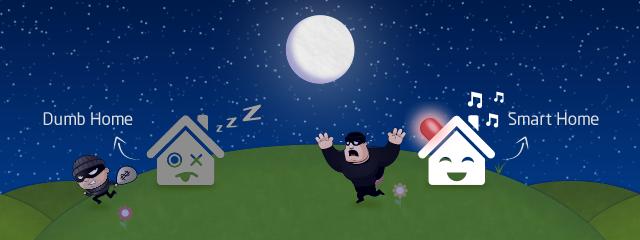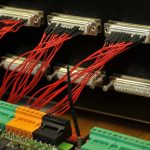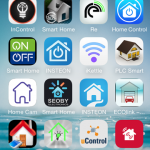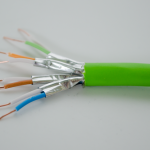
Are Smart Homes Safe? Three “Dangers and Risks” of Smart Homes Explored
Home automation is here to stay, it seems. With market giants such as Google and Apple now jumping on the proverbial automated bandwagon, discussions around the risks of home automation have swelled to record levels. Are smart homes safe? Can my home be hacked? What happens if there’s a power cut?!
In this blog, we’ll be exploring three main ‘risks’ associated with smart homes that we often see discussed in articles and forums, and looking at ways to avoid or address these problems.
Is My Home Vulnerable to Hackers?
 Hackers are not a new concept in the digital age, however, the presence of hackers in the home technology sphere is sparking many discussions over the safety of smart homes. The safety of ‘smart’ devices was recently called into question by media coverage reporting on the story of a couple who were alarmed to find that their baby monitoring webcam had been hacked and was being used to intimidate them. Whilst cases like these are very upsetting, it’s worth bearing in mind that such instances are rare and therefore are easily sensationalised in the national press. This is not to say that there is nothing to be done to prevent a situation like this. There are steps you can take to ensure your home remains out of the reach of hackers.
Hackers are not a new concept in the digital age, however, the presence of hackers in the home technology sphere is sparking many discussions over the safety of smart homes. The safety of ‘smart’ devices was recently called into question by media coverage reporting on the story of a couple who were alarmed to find that their baby monitoring webcam had been hacked and was being used to intimidate them. Whilst cases like these are very upsetting, it’s worth bearing in mind that such instances are rare and therefore are easily sensationalised in the national press. This is not to say that there is nothing to be done to prevent a situation like this. There are steps you can take to ensure your home remains out of the reach of hackers.
First of all, it’s a case of need vs security; do you really need to have remote access to your house? Do you need webcams inside the house, or just an intercom at the door? If you are worried about intruders, presence sensors work very well as part of an integrated alarm system, no webcams needed.
Another way to keep your home private is to ensure that you don’t have any ports opened in your router. If you do decide to have remote access to your home then consider setting up a virtual private network (VPN) rather than opening ports in your router.
Furthermore, with Loxone, you can also restrict which parts of the webinterface can be accessed remotely. So you could have some features such as a holiday mode accessible – but not allow cameras to be accessed outside of the local area network (LAN).
It’s Complicated (AKA Sorry About The Mess)
 Take a look at your phone. Quite a few apps you’ve got there, am I right? There’s no stopping the current trend for developing more and more new devices, each trying to be smarter than the last. The problem with this is that you end up with endless apps on your phone to control each different part of your house! A smart TV here, an iKettle there etc. What good is a Canary that can’t find it’s Nest?! If the clutter from all these apps is becoming even more annoying than Flappy Bird, then perhaps it’s time to try out the Loxone app.
Take a look at your phone. Quite a few apps you’ve got there, am I right? There’s no stopping the current trend for developing more and more new devices, each trying to be smarter than the last. The problem with this is that you end up with endless apps on your phone to control each different part of your house! A smart TV here, an iKettle there etc. What good is a Canary that can’t find it’s Nest?! If the clutter from all these apps is becoming even more annoying than Flappy Bird, then perhaps it’s time to try out the Loxone app.
Our aim is to provide a central interface for all these different products so you can tie them all together and access them through one single app. So for example, when it starts getting dark, the blinds come down, the lights fade up to a nice evening scene and the TV is turned on. If you then pause your TV, the kettle starts to boil! Yes, you might still need to nip into another app to change your favourite Spotify playlist, but you’re significantly cutting down on the clutter and the hassle.
One of the fundamental principles of home automation is simplicity- why make something more complicated than it needs to be?! Would I walk around my home switching every light on and off with my app? Not a chance! That’s what presence sensors, and dare I say, old fashioned wall switches are for!
Peter Aylett has written a great blog about ‘over-automation’ which elaborates on this point nicely. You can check it out here.
Single Point of Failure
 In the wise words of Kirstie and Phil, it’s all about compromise. This problem is ultimately the compromise you’ve made for gaining more control over your home. Since the system is centralised like the engine in your car, you have excellent control of it, however, with any centralised controlled system, there will always be a point of failure.
In the wise words of Kirstie and Phil, it’s all about compromise. This problem is ultimately the compromise you’ve made for gaining more control over your home. Since the system is centralised like the engine in your car, you have excellent control of it, however, with any centralised controlled system, there will always be a point of failure.
You’re putting more of your eggs into one basket, and it’s natural to wonder if it can hold up under the additional weight. Bear in mind, however, that it could be argued that even decentralised control systems still have the problem that the cable or power supply is a single point of failure, and this is the downside to control. It’s not all doom and gloom though, as there are many sensible ways to get around this!
One of the best defences is the use of an uninterruptible power supply (USP) so that in the event of a power cut your system still runs. You could have an additional Miniserver as a backup, you could leave certain emergency lighting circuits on conventionally wired circuits, and you can ensure there is always an SD card with the program saved on site. Our speedy returns procedure ensures that if you have a live install and a product fails, we will replace it immediately, even before you have returned the faulty product. Life has a great way of keeping us on our toes, and sometimes events occur that are out of our control. Just as you’d take your car to the garage if there’s a problem, with Loxone, you have a team ready to get you back on your feet if and when you need it most.
I’m still unsure…
If you’re still on the fence about home automation, get in touch and tell us why! We’ll do our best to alleviate some of the concerns you may have, and suggest alternative ways of setting up a smart home that suits you, and the way you use your home. We offer a free project consultation service, so it’s a perfect opportunity for you to come in and meet us and get answers to your questions in person.
